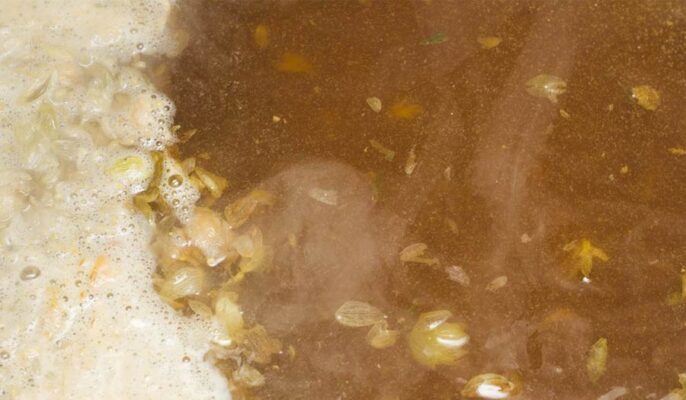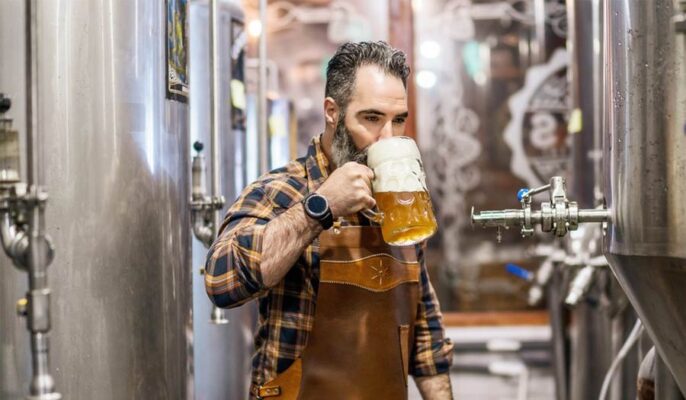Fermentation is the process by which yeast converts the glucose in the wort into ethanol and carbon dioxide gas. To start the fermentation process, the cooled wort is transferred to a fermentation tank to which yeast has been added. Without fermentation, there is no alcohol, no sugar degradation, and no proper flavor development.
Beer fermentation requires yeast
To ferment beer, yeast is required. Yeast converts glucose into carbon dioxide and ethanol during fermentation. This fermentation does not need any oxygen. Yeast is a living microorganisms that must proper culture to thrive. The temperature needs to be right and there has to be enough food (glucose) for the yeast to do its job. Thus, the first few steps of beer brewing are about creating the right environment for yeast to thrive.

How long does it take to ferment beer?
Many brewers wonder what is the optimal time frame for fermenting beer. We cannot control the fermentation time. Once thrown in, the yeast does all the work.
Control fermentation time
Temperature control is a very important part of the fermentation process and can be changed during fermentation. Each yeast strain has a temperature range in which they work best. Different temperatures within this range affect the fermentability of different yeasts. Generally, the lower the temperature, the slower the yeast will act, and the higher the temperature, the faster it will be.
The higher the fermentation temperature, outside the temperature range specified by the yeast, the more likely it is to develop off-flavors and unwanted characteristics in the beer. If lower temperatures are used, sometimes stagnation, extended times, or difficulty in reaching normal fermentation levels may be encountered. Of course, except for some specific styles.
Basic experience with fermentation
Aim for low-to-medium temperatures in the yeast fermentation range. For example, if the range is 18-22°C, it is best to aim for 19-20°C.
Beer fermentation process
Once there is enough “food” in the wort and the first flavor development (by adding hops) is complete, the fermentation process can begin. Yeast are added to the liquid and they can start consuming glucose.
Fermentation doesn’t always start right away. Oxygen is still present at the start, allowing the yeast to breathe instead of ferment. When breathing yeast uses oxygen to break down glucose. Here no ethanol is formed, but the glucose is completely broken down into water and carbon dioxide, obtaining all possible energy from the glucose molecules.
The basic beer fermentation process is the same as that of common yeast fermentation. Glucose is converted to ethanol (alcohol) and carbon dioxide. But, more than the formation of these two molecules occurs during fermentation!
How do you know beer is done fermenting?
A common mistake new winemakers make is using the airlock on the fermenter to gauge progress. A device that ensures nothing gets into the fermenting beer and lets the accumulated CO2 escape. If the fermenter is not sealed , CO2 may escape and the airlock will stop bubbling!
There is only one way to know if a beer has finished fermenting – with a hydrometer or a refractometer. These devices allow you to check the sugar content in your wort/beer.
A general recommendation for knowing when a beer is done and ready to pack is to get a stable Specific Gravity (SG) reading within 2-3 days. This is to ensure that the fermentation has indeed been completed.

What to do after beer fermentation is complete?
Let the beer sit for a few days after fermentation. This will allow the beer to settle and clarify, and the yeast to flocculate at the bottom of the fermenter. If you can lower the heat a bit, we recommend this method as it helps clear the beer.
Immediate packaging is available as an option after fermentation is complete. Would like to age longer, or add other things like fruit, oak, or on their own in some lagers. It all depends on the beer being brewed.
What beer looks like when fermented
Lag period
At this stage, the yeast cells wake up. Start looking for food like a human, such as oxygen, minerals and amino acids. At this stage, due to any remaining temperature stratification, there is no airlock activity and only a small amount of wort is convected in the fermenter.
Fixed period
All the sugar has been eaten and it starts to turn from milky white to yellow and brown. Yeast begins to take up many of the compounds of as off-flavors, such as higher alcohols, diacetyls, sulfur compounds, and esters, and converts them into more alcohol and other “better” esters.
At this point, the fermented wort, known as a “green” beer, has not yet achieved the proper balance of flavors. The airlock and convection start to slow down as the yeast settles and goes to sleep after the long run, exiting the solution as the little food left over disappears.
Work completion stage
Airlock activity may stop (or bubbles) and convection ceases. The yeast is sleeping most of the time at this point, hanging off the bottom of the fermenter. The beer starts to clarify and the flavors in the beer mature.




